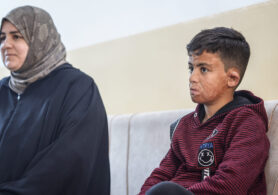The latest report from the UN Special Rapporteur on Extrajudicial Executions, Agnes Callamard, contains a number of pressing questions about the use of drones for targeted killing [1]. Most of them are not new. Much of the media attention surrounding the release of this report focused, understandably, on its declaration that the killing of Iranian General Soleimani was unlawful. Beyond its opinion on this particular attack, however, lie a number of critically important political questions. Many of these have long been subject to debate among scholars of remote warfare. Nevertheless, this report casts them in a new light and invites timely scrutiny.
Callamard’s report is premised on the idea we are entering a new era of remote warfare. It follows previous versions produced by her predecessors for the UN Human Rights Council in 2010 and 2013. In the seven years that have passed since, she observes that the world has entered the “second drone age.” Characterised by the proliferation of drones (armed and unarmed) among a much wider variety of States and non-state actors, this new epoch suggests remote warfare is no longer the reserve of the most technologically-advanced militaries. Drones are being adopted more widely for the same reasons Western militaries pioneered their use in the first drone age: their efficiency, adaptability, deniability, effectiveness, and resulting political appeal for waging low-risk, low-cost wars.
As drones have proliferated, they have also grown more sophisticated. Today, they are stealthier, faster, smaller, more deadly and can be controlled from greater distances than ever before. Despite these technological innovations, however, Callamard astutely notes that the “myth of the precision strike” remains just that: a myth. Enhanced situational awareness on the battlefield afforded by drones does not automatically translate into a “cleaner” or more just war.
Unfortunately, in the absence of any transparency and accountability on behalf of those conducting drone strikes, it is left to civil society to fill the gaps in public knowledge. Reports from organisations like Airwars show that civilian harm caused by drone strikes is often far greater than is officially admitted [2]. Beyond the obvious moral and legal concerns expressed by Callamard, she notes that collateral damage risks alienating local populations and fueling grievances which lead to further conflict. Longer-term effects of this nature may not even be limited to the same geographies as the drone strikes themselves, as the issue of ‘blowback’ suggests. [3]
As drones have proliferated and grown more sophisticated, the international legal regime(s) governing their use has struggled to keep up. In many cases, law has been manipulated to justify targeted killings to such an extent it has effectively become “weaponised.”[4] Instrumental distortions of the geographic and temporal boundaries of warfare over the past two decades are cited as a particular concern by Callamard. Indeed the rise of “unending”[5] and “everywhere”[6] wars is already well-documented, but focused overwhelmingly on the United States. Taken together with the widespread proliferation of drones characteristic of the “second drone age,” the issue of unending and forever wars remains a pressing concern.
Callamard draws attention to a lack of scrutiny and oversight from the international community regarding drone strikes. Warfare that is ambiguous in its geographical and temporal boundaries is, it appears, similarly ambiguous in its interpretation by the international community. In the absence of any systematic review of targeted killings by drones, the silence of states is deafening. The targeted killing of Soleimani is therefore not just a slippery slope, according to Callamard, “it is a cliff.” Today, then, the proliferation of drones in a relatively permissive legal environment threatens the risk of low-intensity conflicts being drawn out much longer, and not solely between the key players of the first drone age. As a result, war is becoming “normalised as the legitimate and necessary companion to peace,” according to Callamard, “not as its opposite we must do all that we can to resist.”
Much of what Callamard has written has already been discussed and debated in academia and civil society for some time. Enduringly relevant as these issues unfortunately are, however, this report draws attention to them at an important time. Proliferation of drones well beyond “the usual suspects” presents the study of remote warfare with a number of new lines of inquiry. What are the tactical and strategic implications of remote warfare becoming the norm among smaller states and non-state actors? As battlefields expand and airspaces grow crowded, how will the threat of drones be countered? What does the proliferation of drones mean for how their use is justified, internationally and domestically? As a “lightning rod” for key questions about the right to life in conflicts, asymmetrical warfare and counterterrorism operations, drones are unlikely to lose their relevance any time soon.
Sources:
- UN News (2020) All drone strikes ‘in self-defence’ should go before Security Council, argues independent rights expert
- Woods, C., Cheeseman, A. (2020) Europe’s shame: Claims by key allies of no civilian harm in war against ISIS exposed
- Hudson, L., Owens, C. S., & Flannes, M. (2011). Drone Warfare: Blowback from the New American Way of War. Middle East Policy, 18(3), 122–132.
- Jones, C. (2016). Travelling Law: Targeted Killing, Lawfare and the Deconstruction of the Battlefield. In A. Lubin & M. Kraidy (Eds.), American Studies Encounters the Middle East.
- Duffield, M. (2007) Development, security and unending war, Polity
- Gregory, D. (2011). The everywhere war. Geographical Journal, 177(3)



